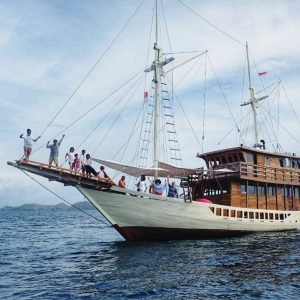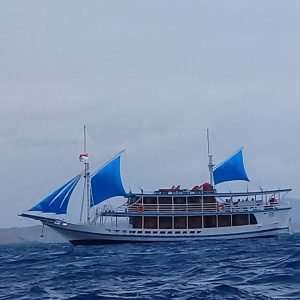Introduction to Komodo National Park Trip
Komodo National Park Trip-Komodo National Park, located in Indonesia, is a remarkable destination that has captured the fascination of travelers and nature enthusiasts alike. Established in 1980 and designated as a UNESCO World Heritage Site in 1991, this park is renowned for its diverse ecosystems and the majestic Komodo dragons, which are the largest lizards on Earth. The park is composed of three large islands—Komodo, Padar, and Rinca—alongside numerous smaller islands, presenting a unique opportunity to explore varied landscapes, including rugged mountains, pristine beaches, and vibrant coral reefs.
The most iconic inhabitant of the park, the Komodo dragon, can be witnessed in its natural habitat, providing an unparalleled wildlife experience. These formidable reptiles can grow over ten feet long and weigh up to 150 pounds, embodying both beauty and power. However, the park is not just about its famous residents; it also boasts an extraordinary range of flora and fauna, some of which are endemic to these islands. This biodiversity is supported by various ecosystems, from tropical forests to savannas, making it a haven for biodiversity.
Moreover, the marine life surrounding Komodo National Park is equally enchanting. The underwater ecosystem is among the most biodiverse in the world, housing over 1,000 species of fish and a variety of coral reefs. Snorkeling and diving opportunities abound, allowing visitors to engage with the vibrant marine life, including turtles, manta rays, and numerous coral species. With its stunning landscapes, rich biodiversity, and opportunities for adventure, Komodo National Park offers a truly irresistible allure, making it a destination worth exploring for those who seek both adventure and natural beauty.
Best Time to Visit Komodo National Park
Determining the best time to visit Komodo National Park is crucial for experiencing its stunning landscapes, diverse wildlife, and exceptional marine life. The ideal seasons hinge on the weather patterns characteristic of the region, especially the distinction between the dry and wet seasons. The dry season, which runs from April to December, is often regarded as the prime time for visitors. During these months, the weather remains relatively dry, with warm temperatures averaging between 30°C to 35°C (86°F to 95°F), making it ideal for outdoor activities such as hiking, snorkeling, and diving.
One of the notable advantages of visiting during the dry season is the opportunity for optimal wildlife sightings. As animals tend to be more active, this period offers visitors a greater chance of encountering the famous Komodo dragons in their natural habitat. Additionally, the visibility underwater is significantly improved, allowing snorkelers and divers to appreciate the vibrant coral reefs and marine life that Komodo National Park is renowned for.
In contrast, the wet season, occurring from January to March, brings increased rainfall and humidity, which may deter some travelers. While this period does possess its unique appeal, including lush green landscapes and fewer crowds, the muddy trails can make hiking more challenging, and the sea conditions may be less favorable for water activities. Nevertheless, for adventurous spirits seeking solitude, this could present an unparalleled opportunity to explore the park’s natural beauty away from the tourist surge.
Ultimately, the best months to plan your visit depend on personal preferences regarding weather and activities. April through June and September through November are particularly recommended for splendid hiking trails, efficient wildlife spotting, and immersive snorkeling experiences. By carefully considering these factors, travelers can optimize their Komodo National Park adventure.
Essential Tips for Your Komodo National Park Trip
Planning a trip to Komodo National Park requires careful consideration to ensure a memorable experience. First and foremost, packing appropriately is crucial. Essential items should include lightweight, moisture-wicking clothing to withstand the tropical climate, a good pair of hiking shoes, and a hat for sun protection. Travelers should also pack swimwear for engaging in marine activities as well as a reusable water bottle to stay hydrated throughout the day. Sunscreen, insect repellent, and a first aid kit are advisable for health and safety purposes.
Understanding local customs and etiquette is equally important while visiting Komodo National Park. The Indonesian culture is diverse, and visitors should respect the traditions of local communities. Dress modestly when visiting villages, and always ask for permission before photographing local residents. Additionally, it is essential to be mindful of the environment. Travelers should adhere to the Leave No Trace principles, refraining from littering and actively helping to protect the park’s fragile ecosystems.
When engaging in activities like hiking or marine excursions, it’s vital to follow safety guidelines. Always choose well-established trails for hiking, and consider joining guided tours for marine activities. Guided tours not only provide safety but also enrich the experience with knowledgeable guides who can share insights about the local flora and fauna. For those inclined toward independent exploration, being well-prepared with maps and information about the area can greatly enhance the adventure. Make sure to familiarize yourself with the park’s regulations, especially regarding wildlife encounters, to ensure both your safety and the well-being of the creatures inhabiting the park.
In conclusion, thoughtful preparation is the key to an unforgettable journey to Komodo National Park. By packing wisely, respecting local customs, and adhering to safety protocols, travelers can optimize their adventure and fully appreciate the unique offerings of this stunning destination.
Exploring Activities and Attractions in Komodo National Park
Komodo National Park trip is a premier destination for outdoor enthusiasts, offering a myriad of activities that cater to various interests. One of the most iconic experiences is trekking in search of the famous Komodo dragons. Guided tours are available that allow visitors to venture into the dragons’ natural habitats on Komodo and Rinca islands. These treks not only provide a thrilling opportunity to observe these magnificent creatures up close but also foster appreciation for the unique ecosystems they inhabit.
Another must-do activity in the Komodo National Park trip is snorkeling or diving at some of the world’s most pristine coral reefs. The crystal-clear waters boast vibrant marine life and stunning coral formations, making it a paradise for divers and snorkelers. Popular spots like Manta Point and Batu Bolong are known for their rich biodiversity, where visitors can encounter manta rays, turtles, and a myriad of colorful fish. These underwater experiences, coupled with the breathtaking natural beauty above water, underscore the allure of the park.
For those who prefer a more laid-back experience, Pink Beach offers a fantastic location for relaxation. With its unique blush-hued sand, this beach is perfect for lounging under the sun or enjoying a picnic amidst picturesque surroundings. Visitors can also take leisurely strolls along the shoreline, soaking in the stunning views of the surrounding landscapes.
Lastly, exploring neighboring islands such as Padar Island can enhance your Komodo National Park trip. Hiking to its viewpoint reveals panoramic vistas that are nothing short of spectacular. By integrating these activities into your travel plans, you can create a bespoke itinerary that highlights the diverse offerings of this breathtaking destination. Komodo National Park trip promises an unforgettable journey filled with exploration, relaxation, and natural beauty.




